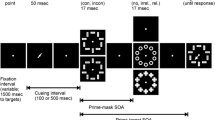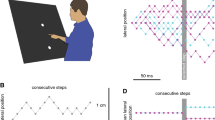Summary
The present study investigated the mechanisms involved in the preparation of pointing movements in humans. We provided visual precues on the location of the upcoming target, and registered the effect of these precues on the reaction time (RT = interval between target appearance and movement onset). Generally, precues were found to reduce RT, suggesting that some aspects of the preparatory process have been advanced in time. In Exp. 1, precues fully specified the direction required for the upcoming movement while indicating only a range of movement amplitudes; in Exp. 2, precues fully specified the amplitude and indicated a range of directions. In both experiments, RT was shorter than in control trials without precues, and gradually increased with the size of the precued amplitude or direction range. This result suggests that the preparation of either parameter is possible without knowing the precise value of the other, i.e. amplitude and direction are not prepared in a fixed order. Furthermore, our results are consistent with the view that movement preparation includes a progressive contraction of the precued range towards the final value. The speed of this process can be estimated as 0.31 cm/ms for amplitude, and 1.7 deg/ms for direction ranges. In Exp. 3 and 4, precues indicated both amplitude and direction as ranges only. The size of the amplitude range was held constant while the size of the direction range was varied (Exp. 3), or vice versa (Exp. 4). Under these conditions, RT increased with the size of the varied range. For all range sizes tested, RT when precuing both amplitude and direction as ranges corresponded to the longer of the two RTs obtained in control trials where only one parameter was precued as range (like in Exp. 1 and 2), This outcome supports the hypothesis that amplitude and direction are prepared in parallel. The contraction speeds of amplitude and direction ranges estimated from Exp. 3 and 4 were comparable to those estimated from Exp. 1 and 2, indicating that processing speed is not reduced if both parameters rather than just one have to be prepared. In Exp. 5, the precued amplitude and direction range was held constant while precue area, and thus the range of possible final arm positions, was varied. RT was independent of precue area, which argues against a major contribution of position control mechanisms. Taken together, the present data support the hypothesis that amplitude and direction are the two most predominant parameters of movement preparation.
Similar content being viewed by others
References
Alexander GE, Crutcher MD (1990) Preparation for movement: Neural representations of intended direction in three motor areas of the monkey. J Neurophysiol 64:133–150
Becker W, Jürgens R (1979) An analysis of the saccadic system by means of double step stimuli. Vision Res 19:967–983
Bizzi E, Accornero N, Chapple W, Hogan N (1984) Posture control and trajectory formation during arm movement. J Neurosci 4:2738–2744
Bock O (1989) A neural network predicting posterior parietal cortex function in the control of goal-directed arm movements. Neural Networks 2:351–358
Bock O (1990) Load compensation in human goal-directed arm movements. Behav Brain Res 41:167–177
Bock O, Eckmiller R (1986) Goal-directed arm movements in absence of visual guidance: evidence for amplitude rather than position control. Exp Brain Res 62:451–458
Bock O, Eckmiller R, Andersen R (1987) Goal-directed pointing movements following chemical microlesions within the posterior parietal cortex of trained monkeys. Soc Neurosci Abstr 13:716
Bock O, Dose M, Ott D, Eckmiller R (1990) Control of arm movements in a 2-dimensional pointing task. Behav Brain Res 40:247–250
Deubel H (1987) Adaptivity of gain and direction in oblique saccades. In: O'Regan JK, Levy-Schoen A (eds) Eye movements: from physiology to cognition. North Holland, Amsterdam, pp 181–190
Eriksen CW, Yeh YY (1985) Allocation of attention in the visual field. J Exp Psychol 11:583–597
Favilla M, Hening W, Ghez C (1989) Trajectory control in targeted force impulses. VI. Independent specification of response amplitude and direction. Exp Brain Res 75:280–294
Favilla M, Gordon J, Hening W, Ghez C (1990) Trajectory control in target force impulses. VII. Independent setting of amplitude and direction in response preparation. Exp Brain Res 79:530–538
Feldman AG (1966) Functional tuning of the nervous system with control of movement or maintenance of a steady posture. II. Controllable parameters of the muscles. Biophysics 11:565–578
Findlay JM (1981) Spatial and temporal factors in the predictive generation of saccadic eye movements. Vision Res 21:347–354
Flanagan JR, Ostry DJ, Feldman AG (1990) Control of human jaw and multijoint arm movements. In: Hammond G (ed) Cerebral control of speech and limb movements. Springer, London, pp-29–58
Georgopoulos AP, Kalaska JF, Massey JT (1981) Spatial trajectories and reaction times of aimed movements: effects of practice, uncertainty, and change in target location. J Neurophysiol 46:725–743
Georgopoulos AP, Caminiti R, Kalaska JF, Massey JT (1983) Spatial coding of movement: a hypothesis concerning the coding of movement direction by motor cortical populations. Exp Brain Res Suppl 7:327–336
Georgopoulos AP, Massey JT (1987) Cognitive spatial-motor processes. 1. The making of movements at various angles from a stimulus direction. Exp Brain Res 65:361–370
Georgopoulos AP, Lurito JT, Petrides M, Schwartz AB, Massey JT (1989) Mental rotation of the neuronal population vector. Science 243:234–236
Godschalk M, Lemon RN, Kuypers HGJM (1981) Behavior of neurons in monkey peri-arcuate and precentral cortex before and during visually guided arm and hand movements. Exp Brain Res 44:113–116
Goodman D, Kelso JAS (1980) Are movements prepared in parts? Not under compatible (naturalized) conditions. J Exp Psychol 109:475–495
Hick WE (1952) On the rate of gain of information. Q J Exp Psychol 4:11–26
Hou RL, Fender DH (1979) Processing of direction and magnitude by the saccadic eye-movement system. Vision Res 19:1421–1426
Hyman R (1953) Stimulus information as a determinant of reaction time. J Exp Psychol 45:188–196
Jeannerod M (1988) The neural and behavioural organization of goal-directed movements. Clarendon, Oxford, pp 14–18
Kalaska JF, Caminiti R, Georgopoulos AP (1983) Cortical mechanisms related to the direction of two dimensional arm movements: relations in parietal area 5 and comparison with motor cortex. Exp Brain Res 51:247–260
Kelso JAS, Holt KG (1980) Exploring a vibratory system analysis of human movement production. J Neurophysiol 43:1183–1196
Larish DD, Frekany GA (1985) Planning and preparing expected and unexpected movements: reexamining the relationship of arm, direction, and extent of movement. J Mot Behav 17:168–189
Lepine D, Glencross D, Requin J (1989) Some experimental evidence for and against a parametric conception of movement precuing. J Exp Psychol 15:347–362
MacKay WA, Bonnet M (1990) CNV, stretch reflex and reaction time correlates of preparation for movement direction and force. Electroenceph Clin Neurophysiol 76:47–62
MacKay WA, Riehle A (1990) Preparatory activity in area 7a related to movement direction and extent. Soc Neurosci Abstr 16:422
Pelisson D, Prablanc C, Goodale MA (1986) Visual control of reaching movements without vision of the limb. II. Evidence for fast nonconscious processes correcting the trajectory of the hand to the final position of a double-step stimulus. Exp Brain Res 62:303–311
Polit A, Bizzi E (1979) Characteristics of motor programs underlying arm movements in monkeys. J Neurophysiol 42:183–194
Posner MI (1980) Orienting of attention. Q J Exp Psychol 32:3–25
Riehle A, Requin J (1989) Monkey primary motor and premotor cortex: single-cell activity related to prior information about direction and extent of an intended movement. J Neurophysiol 61:534–549
Rosenbaum DA (1980) Human movement initiation: specification of arm, direction, and extent. J Exp Psychol 109:444–474
vanSonderen JF, Gielen CCAM, Denier van der Gon JJ (1989) Motor programmes for goal-directed movements are continuously adjusted according to changes in target location. Exp Brain Res 78:139–146
Wise SP, Mauritz KH (1985) Set-related neuronal activity in the premotor cortex of rhesus monkey: effects of changes in motor set. Proc R Soc Lond B Biol Sci 223:190–218
Author information
Authors and Affiliations
Rights and permissions
About this article
Cite this article
Bock, O., Arnold, K. Motor control prior to movement onset: preparatory mechanisms for pointing at visual targets. Exp Brain Res 90, 209–216 (1992). https://doi.org/10.1007/BF00229273
Received:
Accepted:
Issue Date:
DOI: https://doi.org/10.1007/BF00229273




